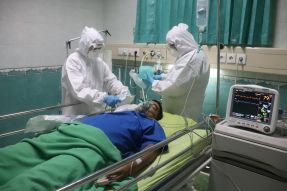Three Key Steps for a Construction Containment Room

This past year has taught many healthcare professionals the importance of having quality containment rooms. These spatial places can effectively isolate patients and spaces from dust and other contaminants that simply cannot get out. But what exactly is a containment room and what do you need to make one that works?
Today we break down everything you need to know about containment rooms, the technology that makes them work, what to look for in your equipment, and what else you need to make the space as safe and effective as possible.
How to Build a Dependable Containment Room
Containment rooms are extremely important and technologically advanced spaces that are designed to fully seal in dust and other contaminants from leaving a specific room. While they are found in other industries, the most common place to find a containment room is in the healthcare industry, where they are used to help keep people isolated and safe during particularly infectious or dangerous
Containment rooms have a number of pieces of technologies, procedures, and construction techniques put in place to help them be a safe and sealed off as possible. Some of these pieces of technology include in the room itself, such as containment units, and other important devices in the HVAC system. The people entering and exiting these rooms will also have their own pieces of equipment and technology to ensure they stay safe and can effectively help whoever is in the containment room. These are usually PPE, or Personal Protective Equipment.
Finally, everyone in the building will need to be briefed on procedures and best practices for the room to ensure that all of its technology is used to maximum effectiveness. Without this final piece, the best containment units and PPE in the world will be of little use.
What are Containment Units?
The key piece of technology for constructing a containment room is a mobile containment unit. Units like the ECU4 are designed to help make many different types of rooms into dependable and safe containment rooms.
A mobile containment unit, broadly speaking, is a portable piece of technology that isolates a space from the surrounding area. This is usually accomplished in conjunction with portable barriers to ensure the room is completely insulated from the outside world. Without this piece, you simply cannot build an effective containment room.
The Key Aspects to Look for in a Containment Unit
While many containment units are different, many have a few features that are fairly common. Many also incorporate negative air machines and HEPA and ULPA filtration systems, along with additional features that combine dust containment solutions for the convenience of your staff.
If you are looking to purchase a mobile containment unit, then there are a few things that you should consider. First among them is integration with or compatibility with your building and technology. Always look for a system that fits, or be sure that any changes that need to be made can be done effectively and without significant investment.
Mobile containment units also often have features that aren’t flashy but are very important. These can include things like resin zippers, repositioned set up and release pins and upgraded internal operational springs.
Conclusion
If you are in the healthcare industry or in another industry that requires an isolated space that is safe from dust and other contaminants, then you likely require a containment room. These spatial rooms are the perfect solution for keeping a space free of these dangerous particles and from having them travel outside. The most important part of any containment room is the mobile containment unit that will filter out dust and properly isolate the space, but remember that it is just one piece of a much larger puzzle.
Every containment room requires a containment unit along with effective barriers, PPE, and policies and procedures that will keep everyone safe. Without every one of these pieces, the containment room will not be effective and even the best mobile containment unit will be rendered useless. So, when building your containment room, be sure to think about the larger picture, including finding the right technology and training your staff on important considerations they need to execute their jobs effectively. With that all in place, you will have an effective containment room that keeps people and patients safe.
